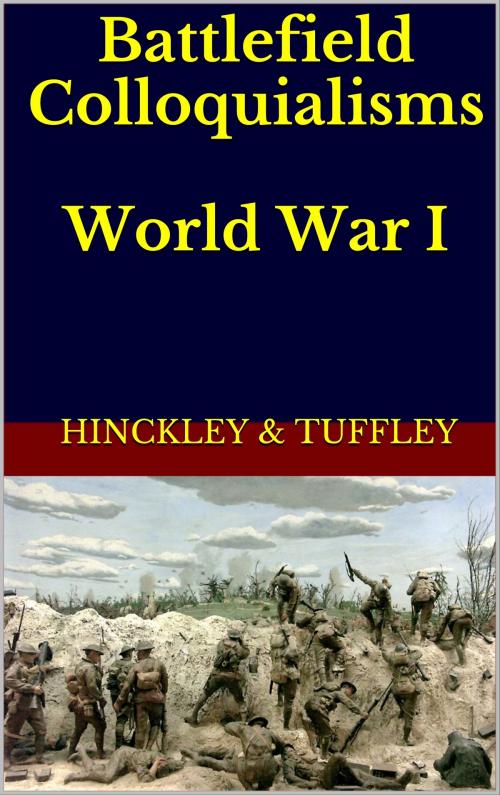Battlefield Colloquialisms of World War I (1914-1918)
Nonfiction, Reference & Language, Dictionaries, Biography & Memoir, Historical| Author: | Paul Hinckley | ISBN: | 9781301970315 |
| Publisher: | Altiora Publications | Publication: | August 8, 2013 |
| Imprint: | Smashwords Edition | Language: | English |
| Author: | Paul Hinckley |
| ISBN: | 9781301970315 |
| Publisher: | Altiora Publications |
| Publication: | August 8, 2013 |
| Imprint: | Smashwords Edition |
| Language: | English |
All kinds of groups develop their own slang, and the military is no exception. Slang is an in-group language which has to be understood if you are to be accepted as a member. An outsider can pretend to be a member, but unless they know the slang, they will not be accepted.
On the Western Front, infiltrators and spies were a threat. The battlefield slang that developed over the course of the war helped to validate a person’s allegiance.
In strongly hierarchical groups like the military, the enlisted men use slang to have a laugh at the expense of the officers, what linguists call ‘diminishing the dignity of the formal language’.
The totality of the British armed forces was diverse. It comprised not just British soldiers. It also included soldiers from English-speaking former British colonies like Australia, Canada, India, South Africa and New Zealand.
The colloquialisms of the British soldier are colourful and often irreverent for the reason mentioned earlier. Many come from Indian and Arabic words acquired during earlier military actions in India and Egypt. Other colloquialisms are Anglicised words, phrases and place names learned from their French allies.
The military phonetic alphabet, known as Signalese, also contributed substantially to the battlefield colloquiums of World War I. The term ‘Ack-Emma’ for example means in the morning, or AM, and comes from the phonetic alphabet as listed below.
In 1918, the British military alphabet was; Ack, Beer, Cork, Don, Eddy, Freddy, George, Harry, Ink, Jug, King, London, Emma, Nuts, Orange, Pip, Quad, Robert, Esses, Toc, Uncle, Vic, William, Xerxes, Yellow, Zebra.
A-1. First rate, by 1916 the British War Office had instituted a nine point rating scale for recruit fitness; A-1 to A-3, B-1 to B-3, C-1 to C-3.
ABDUL. Turk, the individual or collective term for Turkish people. Ottoman Turkey was a member of the Central Powers.
ABOUT TURN. Hébuterne, a French village in the Department of Pas de Calais. For much of the war Hébuterne was on the Western Front and occupied by entrenched Allied Forces on the Eastern side of the village facing the Imperial German Army 800 yards beyond occupying the village of Gommecourt.
ABRI. A dugout to shelter from bombardment. Deriving from the French.
ACE. An outstanding aviator, literally a high-card to play against the enemy. Later in the war, it came to mean a pilot who had made at least 25 kills.
ACCESSORY. Poisonous gas deployed from cylinders. Accessory was a code word used in communiqués in an attempt to keep the practice secret.
ACK-ACK. Anti-aircraft (AA) fire. ‘Ack’ was the first letter of the military phonetic alphabet.
ACK EMMA (1) Military phonetic alphabet for AM as in morning or ante meridiem, (2) Air Mechanic (RFC/RAF).
ALLEY. Go! Get Clear! From the French word allez.
ALLEYMAN. German soldier (from French word for German ‘Allemagne’).
ALLY SLOPER'S CAVALRY. Army Service Corps (ASC). Ally Sloper was a fictional character drawn by W F Thomas that appeared in the popular pre-war paper Ally Sloper's Weekly. The ASC with their non-combatant role were held on low regard by the Infantry. In 1919, when the ASC became the RASC their nickname was changed to Run Away, Someone's Coming.
AMMO BOOTS. Standard issue, hobnail boots worn by the Infantry (from the term ‘ammunition boots’).
ANZAC. Australian and New Zealand Army Corps. The collective name for participating units from these countries.
ARCHIE. Anti-aircraft fire or artillery piece, from a popular music hall character.
All kinds of groups develop their own slang, and the military is no exception. Slang is an in-group language which has to be understood if you are to be accepted as a member. An outsider can pretend to be a member, but unless they know the slang, they will not be accepted.
On the Western Front, infiltrators and spies were a threat. The battlefield slang that developed over the course of the war helped to validate a person’s allegiance.
In strongly hierarchical groups like the military, the enlisted men use slang to have a laugh at the expense of the officers, what linguists call ‘diminishing the dignity of the formal language’.
The totality of the British armed forces was diverse. It comprised not just British soldiers. It also included soldiers from English-speaking former British colonies like Australia, Canada, India, South Africa and New Zealand.
The colloquialisms of the British soldier are colourful and often irreverent for the reason mentioned earlier. Many come from Indian and Arabic words acquired during earlier military actions in India and Egypt. Other colloquialisms are Anglicised words, phrases and place names learned from their French allies.
The military phonetic alphabet, known as Signalese, also contributed substantially to the battlefield colloquiums of World War I. The term ‘Ack-Emma’ for example means in the morning, or AM, and comes from the phonetic alphabet as listed below.
In 1918, the British military alphabet was; Ack, Beer, Cork, Don, Eddy, Freddy, George, Harry, Ink, Jug, King, London, Emma, Nuts, Orange, Pip, Quad, Robert, Esses, Toc, Uncle, Vic, William, Xerxes, Yellow, Zebra.
A-1. First rate, by 1916 the British War Office had instituted a nine point rating scale for recruit fitness; A-1 to A-3, B-1 to B-3, C-1 to C-3.
ABDUL. Turk, the individual or collective term for Turkish people. Ottoman Turkey was a member of the Central Powers.
ABOUT TURN. Hébuterne, a French village in the Department of Pas de Calais. For much of the war Hébuterne was on the Western Front and occupied by entrenched Allied Forces on the Eastern side of the village facing the Imperial German Army 800 yards beyond occupying the village of Gommecourt.
ABRI. A dugout to shelter from bombardment. Deriving from the French.
ACE. An outstanding aviator, literally a high-card to play against the enemy. Later in the war, it came to mean a pilot who had made at least 25 kills.
ACCESSORY. Poisonous gas deployed from cylinders. Accessory was a code word used in communiqués in an attempt to keep the practice secret.
ACK-ACK. Anti-aircraft (AA) fire. ‘Ack’ was the first letter of the military phonetic alphabet.
ACK EMMA (1) Military phonetic alphabet for AM as in morning or ante meridiem, (2) Air Mechanic (RFC/RAF).
ALLEY. Go! Get Clear! From the French word allez.
ALLEYMAN. German soldier (from French word for German ‘Allemagne’).
ALLY SLOPER'S CAVALRY. Army Service Corps (ASC). Ally Sloper was a fictional character drawn by W F Thomas that appeared in the popular pre-war paper Ally Sloper's Weekly. The ASC with their non-combatant role were held on low regard by the Infantry. In 1919, when the ASC became the RASC their nickname was changed to Run Away, Someone's Coming.
AMMO BOOTS. Standard issue, hobnail boots worn by the Infantry (from the term ‘ammunition boots’).
ANZAC. Australian and New Zealand Army Corps. The collective name for participating units from these countries.
ARCHIE. Anti-aircraft fire or artillery piece, from a popular music hall character.















